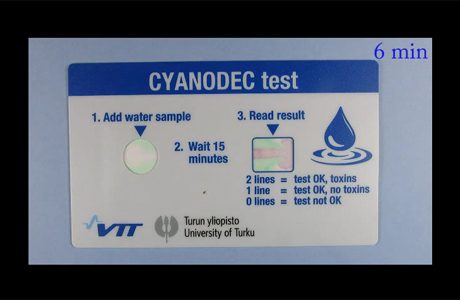
VTT Technical Research Centre of Finland and the University of Turku have developed an easy-to-use and affordable blue-green algae (cyanobacteria) test. The testing device enables ordinary consumers to check that the water at their beach is free of cyanobacteria toxins. The developers are now looking at avenues for commercialising the device.
The cyanobacteria testing device, which is said to be suitable for mass production and the size of a bank card, can be used both by consumers and authorities. The disposable, paper-based testing device can identify the occurrence of the most common cyanobacteria toxins, such as microcystins and nodularins.
“The cyanobacteria test requires only a few drops of water and indicates the result within 15 minutes. If two red lines appear on the display, the water contains cyanobacteria toxins. One line means that the water sample is toxin free,” said VTT Senior Scientist Liisa Hakola.
As lake and sea waters warm up, the annual summer monitoring of blue-green algae blooms begins. Toxins are present in approximately every second blue-green algae bloom and you cannot detect by visual inspection alone whether the cyanobacteria in the water is toxic or not.
“Even after the blue-green algae disappear, the water might contain toxins for a while. With the device, you can quickly check that the water is safe to use,” says Markus Vehniäinen, Researcher at the University of Turku.
The joint project of the University of Turku and VTT aimed to meet the need of consumers to obtain up-to-date information about the state of their water bodies by developing an affordable, fast and easy-to-use-solution. If transferred to an automated testing platform, the assay would also be suitable for applications requiring particular measurement sensitivity, such those for testing drinking water around the world.
The cyanobacteria test has been developed as part of a project to create new knowledge and business from research ideas funded by Tekes. It has been found to work also in natural water samples, and a commercialising company is currently being sought so that the test can be made available to consumers.
The national algal bloom monitoring bulletin published by the Finnish Environment Institute gives a general picture of the state of the water bodies in Finland and Järviwiki monitors the occurrence of blue-green algae in individual lakes and water bodies. Such detailed information on water quality has not previously been available.
A video explains more at https://www.youtube.com/watch?v=WhgwaOS_-ek.






